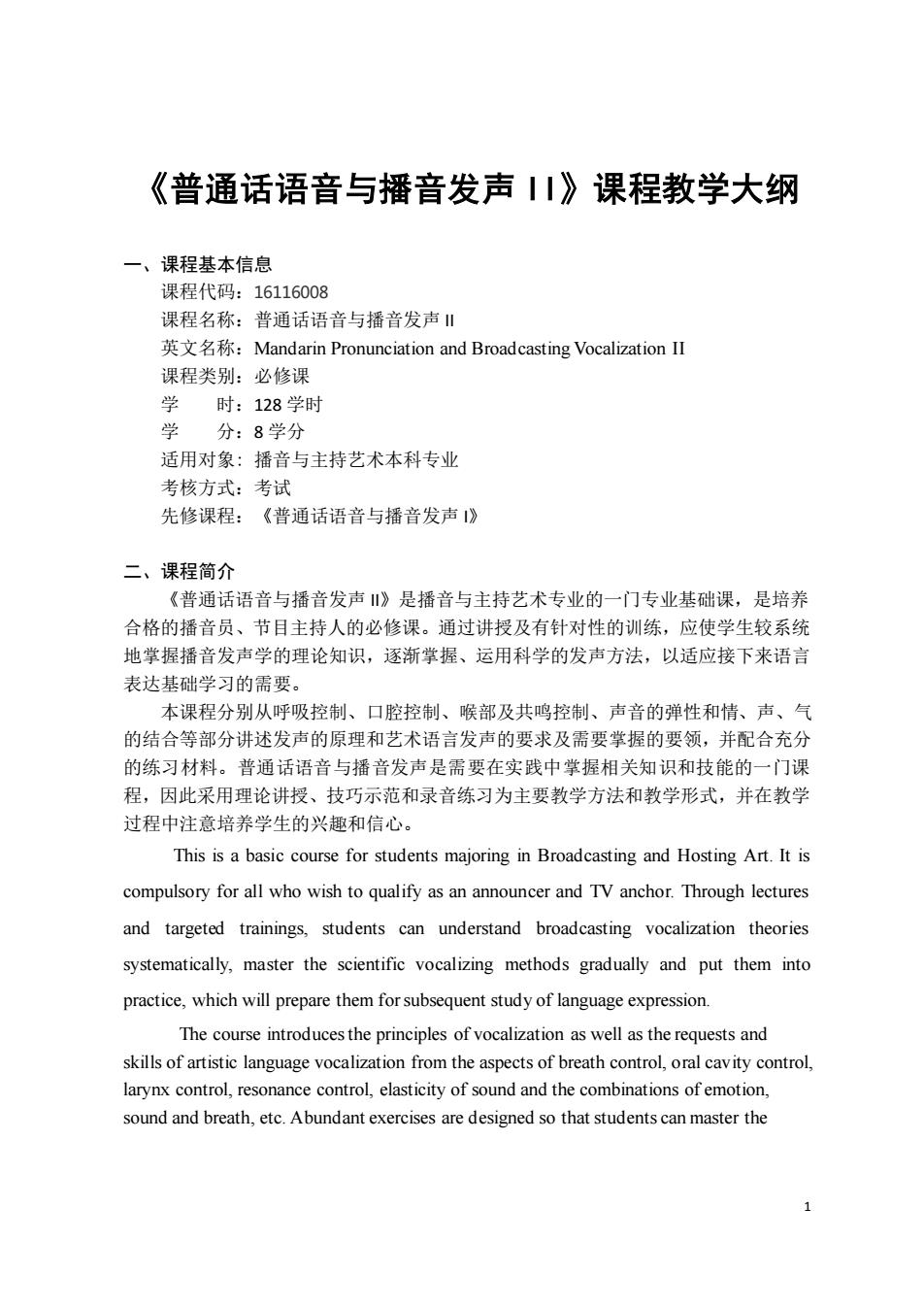正在加载图片...

《普通话语音与播音发声I》课程教学大纲 一、课程基本信息 课程代码:16116008 课程名称:普通话语音与播音发声Ⅱ 英文名称:Mandarin Pronunciation and Broadcasting Vocalization IⅡ 课程类别:必修课 学时:128学时 学 分:8学分 适用对象:播音与主持艺术本科专业 考核方式:考试 先修课程:《普通话语音与播音发声》 二、课程简介 《普通话语音与播音发声Ⅱ》是播音与主持艺术专业的一门专业基础课,是培养 合格的播音员、节目主持人的必修课。通过讲授及有针对性的训练,应使学生较系统 地掌握播音发声学的理论知识,逐渐掌握、运用科学的发声方法,以适应接下来语言 表达基础学习的需要。 本课程分别从呼吸控制、口腔控制、喉部及共鸣控制、声音的弹性和情、声、气 的结合等部分讲述发声的原理和艺术语言发声的要求及需要掌握的要领,并配合充分 的练习材料。普通话语音与播音发声是需要在实践中掌握相关知识和技能的一门课 程,因此采用理论讲授、技巧示范和录音练习为主要教学方法和教学形式,并在教学 过程中注意培养学生的兴趣和信心。 This is a basic course for students majoring in Broadcasting and Hosting Art.It is compulsory for all who wish to qualify as an announcer and TV anchor.Through lectures and targeted trainings,students can understand broadcasting vocalization theories systematically,master the scientific vocalizing methods gradually and put them into practice,which will prepare them for subsequent study of language expression. The course introduces the principles of vocalization as well as the requests and skills of artistic language vocalization from the aspects of breath control,oral cavity control. larynx control.resonance control.elasticity of sound and the combinations of emotion. sound and breath,etc.Abundant exercises are designed so that students can master the 1 《普通话语音与播音发声 II》课程教学大纲 一、课程基本信息 课程代码:16116008 课程名称:普通话语音与播音发声 II 英文名称:Mandarin Pronunciation and Broadcasting Vocalization II 课程类别:必修课 学 时:128 学时 学 分:8 学分 适用对象: 播音与主持艺术本科专业 考核方式:考试 先修课程:《普通话语音与播音发声 I》 二、课程简介 《普通话语音与播音发声 II》是播音与主持艺术专业的一门专业基础课,是培养 合格的播音员、节目主持人的必修课。通过讲授及有针对性的训练,应使学生较系统 地掌握播音发声学的理论知识,逐渐掌握、运用科学的发声方法,以适应接下来语言 表达基础学习的需要。 本课程分别从呼吸控制、口腔控制、喉部及共鸣控制、声音的弹性和情、声、气 的结合等部分讲述发声的原理和艺术语言发声的要求及需要掌握的要领,并配合充分 的练习材料。普通话语音与播音发声是需要在实践中掌握相关知识和技能的一门课 程,因此采用理论讲授、技巧示范和录音练习为主要教学方法和教学形式,并在教学 过程中注意培养学生的兴趣和信心。 This is a basic course for students majoring in Broadcasting and Hosting Art. It is compulsory for all who wish to qualify as an announcer and TV anchor. Through lectures and targeted trainings, students can understand broadcasting vocalization theories systematically, master the scientific vocalizing methods gradually and put them into practice, which will prepare them for subsequent study of language expression. The course introduces the principles of vocalization as well as the requests and skills of artistic language vocalization from the aspects of breath control, oral cavity control, larynx control, resonance control, elasticity of sound and the combinations of emotion, sound and breath, etc. Abundant exercises are designed so that students can master the